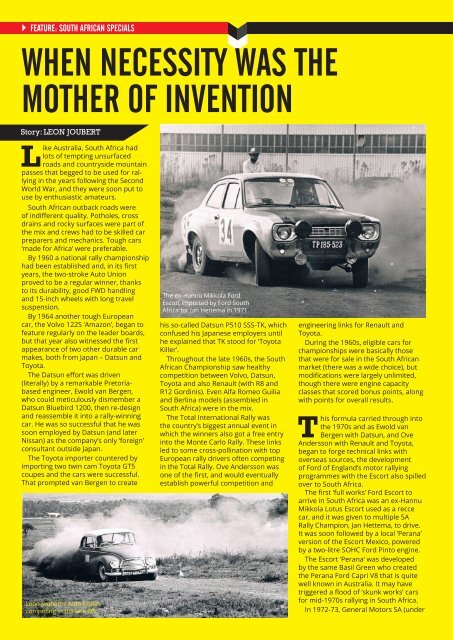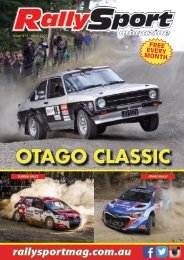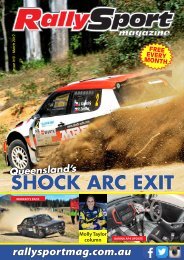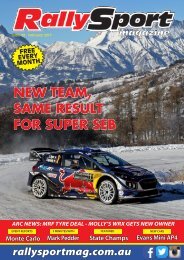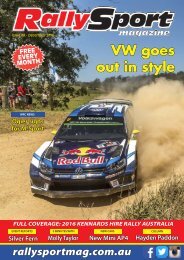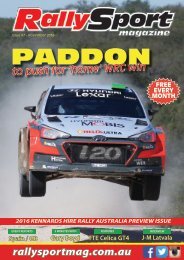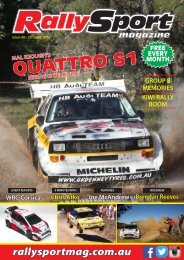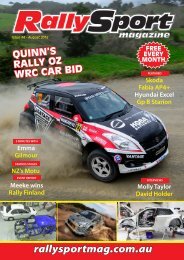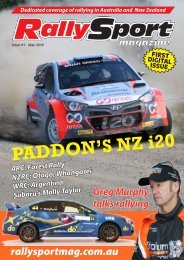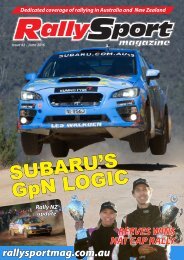RallySport Magazine September 2016
The September issue of RallySport Magazine features the latest rallying news form Australia and New Zealand, including coverage of the World Rally Championship.
The September issue of RallySport Magazine features the latest rallying news form Australia and New Zealand, including coverage of the World Rally Championship.
Create successful ePaper yourself
Turn your PDF publications into a flip-book with our unique Google optimized e-Paper software.
FEATURE: SOUTH AFRICAN SPECIALS<br />
WHEN NECESSITY WAS THE<br />
MOTHER OF INVENTION<br />
Story: LEON JOUBERT<br />
Like Australia, South Africa had<br />
lots of tempting unsurfaced<br />
roads and countryside mountain<br />
passes that begged to be used for rallying<br />
in the years following the Second<br />
World War, and they were soon put to<br />
use by enthusiastic amateurs.<br />
South African outback roads were<br />
of indifferent quality. Potholes, cross<br />
drains and rocky surfaces were part of<br />
the mix and crews had to be skilled car<br />
preparers and mechanics. Tough cars<br />
‘made for Africa’ were preferable.<br />
By 1960 a national rally championship<br />
had been established and, in its first<br />
years, the two-stroke Auto Union<br />
proved to be a regular winner, thanks<br />
to its durability, good FWD handling<br />
and 15-inch wheels with long travel<br />
suspension.<br />
By 1964 another tough European<br />
car, the Volvo 122S ‘Amazon’, began to<br />
feature regularly on the leader boards,<br />
but that year also witnessed the first<br />
appearance of two other durable car<br />
makes, both from Japan – Datsun and<br />
Toyota.<br />
The Datsun effort was driven<br />
(literally) by a remarkable Pretoriabased<br />
engineer, Ewold van Bergen,<br />
who could meticulously dismember a<br />
Datsun Bluebird 1200, then re-design<br />
and reassemble it into a rally-winning<br />
car. He was so successful that he was<br />
soon employed by Datsun (and later<br />
Nissan) as the company’s only ‘foreign’<br />
consultant outside Japan.<br />
The Toyota importer countered by<br />
importing two twin cam Toyota GT5<br />
coupes and the cars were successful.<br />
That prompted van Bergen to create<br />
Leon Joubert’s Auto Union<br />
competing in the late 60s.<br />
The ex-Hannu Mikkola Ford<br />
Escort imported by Ford South<br />
Africa for Jan Hettema in 1971.<br />
his so-called Datsun P510 SSS-TK, which<br />
confused his Japanese employers until<br />
he explained that TK stood for ‘Toyota<br />
Killer’.<br />
Throughout the late 1960s, the South<br />
African Championship saw healthy<br />
competition between Volvo, Datsun,<br />
Toyota and also Renault (with R8 and<br />
R12 Gordinis). Even Alfa Romeo Guilia<br />
and Berlina models (assembled in<br />
South Africa) were in the mix.<br />
The Total International Rally was<br />
the country’s biggest annual event in<br />
which the winners also got a free entry<br />
into the Monte Carlo Rally. These links<br />
led to some cross-pollination with top<br />
European rally drivers often competing<br />
in the Total Rally. Ove Andersson was<br />
one of the first, and would eventually<br />
establish powerful competition and<br />
engineering links for Renault and<br />
Toyota.<br />
During the 1960s, eligible cars for<br />
championships were basically those<br />
that were for sale in the South African<br />
market (there was a wide choice), but<br />
modifications were largely unlimited,<br />
though there were engine capacity<br />
classes that scored bonus points, along<br />
with points for overall results.<br />
This formula carried through into<br />
the 1970s and as Ewold van<br />
Bergen with Datsun, and Ove<br />
Andersson with Renault and Toyota,<br />
began to forge technical links with<br />
overseas sources, the development<br />
of Ford of England’s motor rallying<br />
programmes with the Escort also spilled<br />
over to South Africa.<br />
The first ‘full works’ Ford Escort to<br />
arrive in South Africa was an ex-Hannu<br />
Mikkola Lotus Escort used as a recce<br />
car, and it was given to multiple SA<br />
Rally Champion, Jan Hettema, to drive.<br />
It was soon followed by a local ‘Perana’<br />
version of the Escort Mexico, powered<br />
by a two-litre SOHC Ford Pinto engine.<br />
The Escort ‘Perana’ was developed<br />
by the same Basil Green who created<br />
the Perana Ford Capri V8 that is quite<br />
well known in Australia. It may have<br />
triggered a flood of ‘skunk works’ cars<br />
for mid-1970s rallying in South Africa.<br />
In 1972-73, General Motors SA (under<br />
64 | RALLYSPORT MAGAZINE - SEPTEMBER <strong>2016</strong>


